Elliptic Cryptocurrency Transactions#
Author: Adi Kondepudi
https://www.kaggle.com/datasets/ellipticco/elliptic-data-set?resource=download
The elliptic data set maps bitcoin transfers between entities, both licit and illicit.
There are 203,769 nodes and 234,355 edges. Nodes are entities and edges are transactions.
Among the nodes, 2% (4545) are illicit and 21% (42019) are licit. The rest are unknown.
There are 166 features for each node.
The first feature is the time step for that node. Each time step represents a connected component of nodes with edges (transactions) that have all occured within three hours of each other.
The next 93 features give information about the transactions made by that node (fees, volume, averages, etc).
The last 72 features are aggregated from adjacent nodes.
# Importing general libraries.
# Specific functions and whatnot will be imported seperately in later cells.
import numpy as np
import pandas as pd
import matplotlib.pyplot as plt
import seaborn as sns
import networkx as nx
import graspologic
import matplotlib.pyplot as plt
# reading data
df_features = pd.read_csv("./elliptic/elliptic_txs_features.csv", header=None)
df_classes= pd.read_csv("./elliptic/elliptic_txs_classes.csv")
df_edgelist = pd.read_csv("./elliptic/elliptic_txs_edgelist.csv")
# renaming columns
df_classes.loc[df_classes['class'] == '1', 'class'] = "illicit"
df_classes.loc[df_classes['class'] == '2', 'class'] = "licit"
df_features.columns = ["id", "time step"] + [f"local_feat_{i}" for i in range(93)] + [f"agg_feat_{i}" for i in range(72)]
df_classes.columns = ["id", "class"]
# adding class data
df = pd.merge(df_features, df_classes, how="inner", on="id")
second_column = df.pop('class')
df.insert(1, 'class', second_column)
df.head()
| id | class | time step | local_feat_0 | local_feat_1 | local_feat_2 | local_feat_3 | local_feat_4 | local_feat_5 | local_feat_6 | ... | agg_feat_62 | agg_feat_63 | agg_feat_64 | agg_feat_65 | agg_feat_66 | agg_feat_67 | agg_feat_68 | agg_feat_69 | agg_feat_70 | agg_feat_71 | |
|---|---|---|---|---|---|---|---|---|---|---|---|---|---|---|---|---|---|---|---|---|---|
| 0 | 230425980 | unknown | 1 | -0.171469 | -0.184668 | -1.201369 | -0.121970 | -0.043875 | -0.113002 | -0.061584 | ... | -0.562153 | -0.600999 | 1.461330 | 1.461369 | 0.018279 | -0.087490 | -0.131155 | -0.097524 | -0.120613 | -0.119792 |
| 1 | 5530458 | unknown | 1 | -0.171484 | -0.184668 | -1.201369 | -0.121970 | -0.043875 | -0.113002 | -0.061584 | ... | 0.947382 | 0.673103 | -0.979074 | -0.978556 | 0.018279 | -0.087490 | -0.131155 | -0.097524 | -0.120613 | -0.119792 |
| 2 | 232022460 | unknown | 1 | -0.172107 | -0.184668 | -1.201369 | -0.121970 | -0.043875 | -0.113002 | -0.061584 | ... | 0.670883 | 0.439728 | -0.979074 | -0.978556 | -0.098889 | -0.106715 | -0.131155 | -0.183671 | -0.120613 | -0.119792 |
| 3 | 232438397 | licit | 1 | 0.163054 | 1.963790 | -0.646376 | 12.409294 | -0.063725 | 9.782742 | 12.414558 | ... | -0.577099 | -0.613614 | 0.241128 | 0.241406 | 1.072793 | 0.085530 | -0.131155 | 0.677799 | -0.120613 | -0.119792 |
| 4 | 230460314 | unknown | 1 | 1.011523 | -0.081127 | -1.201369 | 1.153668 | 0.333276 | 1.312656 | -0.061584 | ... | -0.511871 | -0.400422 | 0.517257 | 0.579382 | 0.018279 | 0.277775 | 0.326394 | 1.293750 | 0.178136 | 0.179117 |
5 rows × 168 columns
# Grouping dataset by timestep and sorting from largest to smallest.
# Time step 1 is the largest with 7880 entities and time step 27 is the smallest with 1089 entities.
df2 = df.groupby(['time step'])['time step'].count().sort_values(ascending=False)
df2
time step
1 7880
42 7140
5 6803
10 6727
3 6621
36 6393
7 6048
22 5894
4 5693
45 5598
35 5507
41 5342
47 5121
43 5063
9 4996
44 4975
24 4592
2 4544
13 4528
32 4525
40 4481
8 4457
6 4328
11 4296
20 4291
29 4275
23 4165
15 3639
21 3537
46 3519
19 3506
17 3385
37 3306
33 3151
16 2975
48 2954
38 2891
31 2816
39 2760
26 2523
34 2486
30 2483
49 2454
25 2314
12 2047
14 2022
18 1976
28 1653
27 1089
Name: time step, dtype: int64
grouped = df.groupby(['time step', 'class'])['id'].count().reset_index().rename(columns={'id': 'count'})
ax = sns.lineplot(x='time step', y='count', hue='class', data=grouped)
sns.move_legend(ax, "lower center", bbox_to_anchor=(.5, 1), ncol=3, title=None, frameon=False)
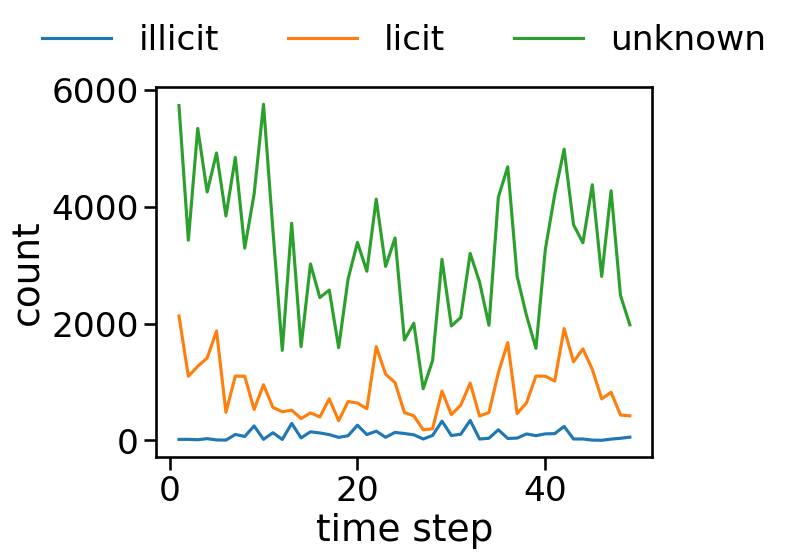
grouped_illicit = grouped[grouped["class"] == "illicit"]
grouped_illicit.sort_values(by="count", ascending=False)
| time step | class | count | |
|---|---|---|---|
| 93 | 32 | illicit | 342 |
| 84 | 29 | illicit | 329 |
| 36 | 13 | illicit | 291 |
| 57 | 20 | illicit | 260 |
| 24 | 9 | illicit | 248 |
| 123 | 42 | illicit | 239 |
| 102 | 35 | illicit | 182 |
| 63 | 22 | illicit | 158 |
| 42 | 15 | illicit | 147 |
| 69 | 24 | illicit | 137 |
| 30 | 11 | illicit | 131 |
| 45 | 16 | illicit | 128 |
| 72 | 25 | illicit | 118 |
| 120 | 41 | illicit | 116 |
| 117 | 40 | illicit | 112 |
| 111 | 38 | illicit | 111 |
| 90 | 31 | illicit | 106 |
| 18 | 7 | illicit | 102 |
| 60 | 21 | illicit | 100 |
| 48 | 17 | illicit | 99 |
| 75 | 26 | illicit | 96 |
| 81 | 28 | illicit | 85 |
| 87 | 30 | illicit | 83 |
| 114 | 39 | illicit | 81 |
| 54 | 19 | illicit | 80 |
| 21 | 8 | illicit | 67 |
| 144 | 49 | illicit | 56 |
| 66 | 23 | illicit | 53 |
| 51 | 18 | illicit | 52 |
| 39 | 14 | illicit | 43 |
| 108 | 37 | illicit | 40 |
| 99 | 34 | illicit | 37 |
| 141 | 48 | illicit | 36 |
| 105 | 36 | illicit | 33 |
| 9 | 4 | illicit | 30 |
| 78 | 27 | illicit | 24 |
| 126 | 43 | illicit | 24 |
| 129 | 44 | illicit | 24 |
| 96 | 33 | illicit | 23 |
| 138 | 47 | illicit | 22 |
| 27 | 10 | illicit | 18 |
| 3 | 2 | illicit | 18 |
| 0 | 1 | illicit | 17 |
| 33 | 12 | illicit | 16 |
| 6 | 3 | illicit | 11 |
| 12 | 5 | illicit | 8 |
| 132 | 45 | illicit | 5 |
| 15 | 6 | illicit | 5 |
| 135 | 46 | illicit | 2 |
sns.lineplot(x='time step', y='count', data=grouped_illicit)
<AxesSubplot: xlabel='time step', ylabel='count'>
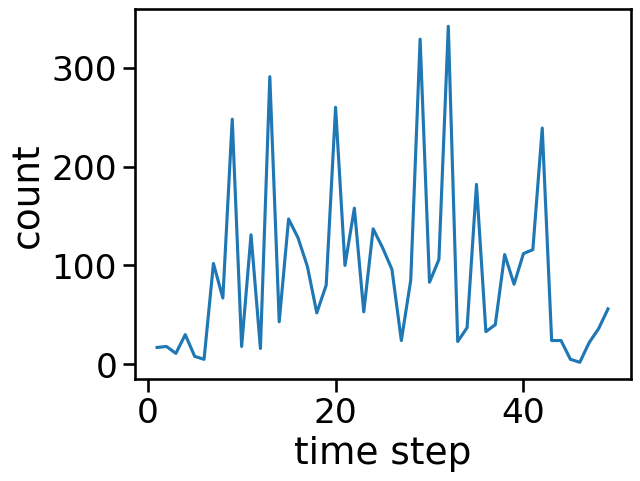
# Using PyTorch to use a neural network to classify the unknown values
import torch
from torch.utils.data import DataLoader, TensorDataset
# df with known valyes
df_licit_illicit = df[df["class"] != "unknown"]
y = df_licit_illicit.iloc[:, 0:2]
y = y.drop(["id"], axis=1).values
X = df_licit_illicit.drop(["class", "id", "time step"], axis=1).values
from sklearn.preprocessing import LabelEncoder
le = LabelEncoder()
y = y.ravel()
y = le.fit_transform(y)
X_tensor = torch.from_numpy(X).float()
y_tensor = torch.from_numpy(y).long()
# Create a TensorDataset to hold the data
data = TensorDataset(X_tensor, y_tensor)
# Split the data into training and test sets
train_data, test_data = torch.utils.data.random_split(data, [int(0.8 * len(data)), len(data) - int(0.8 * len(data))])
# Create data loaders for the training and test sets
train_loader = DataLoader(train_data, batch_size=32, shuffle=True)
test_loader = DataLoader(test_data, batch_size=32, shuffle=True)
# Define the neural network
class Net(torch.nn.Module):
def __init__(self):
super(Net, self).__init__()
self.fc1 = torch.nn.Linear(in_features=X.shape[1], out_features=64)
self.fc2 = torch.nn.Linear(in_features=64, out_features=64)
self.fc3 = torch.nn.Linear(in_features=64, out_features=len(set(y)))
def forward(self, x):
x = torch.nn.functional.relu(self.fc1(x))
x = torch.nn.functional.relu(self.fc2(x))
x = self.fc3(x)
return x
# Create an instance of the network
net = Net()
# Define the loss function and optimizer
criterion = torch.nn.CrossEntropyLoss()
optimizer = torch.optim.Adam(net.parameters(), lr=0.001)
# Train the network
for epoch in range(10):
for inputs, labels in train_loader:
optimizer.zero_grad()
outputs = net(inputs)
loss = criterion(outputs, labels)
loss.backward()
optimizer.step()
# # Test the network
with torch.no_grad():
correct = 0
total = 0
for inputs, labels in test_loader:
outputs = net(inputs)
_, predicted = torch.max(outputs.data, 1)
total += labels.size(0)
correct += (predicted == labels).sum().item()
print(f'Accuracy on test data: {correct / total}')
# creating df of unknown values
df_unknown = df[df["class"] == "unknown"]
df_unknown = df_unknown.drop(['class', 'time step', "id"], axis=1)
df_unknown = df_unknown.values
df_unknown_tensor = torch.from_numpy(df_unknown).float()
# Use the neural network to classify the new data
with torch.no_grad():
# Run the new data through the network
output = net(df_unknown_tensor)
# Get the predicted class for each sample
_, predicted = torch.max(output.data, 1)
predicted = predicted.cpu()
predicted = le.inverse_transform(predicted)
df_df_unknown = df[df["class"] == "unknown"]
df_df_unknown = df_df_unknown.drop(['class', 'time step', "id"], axis=1)
df_df_unknown['classes'] = predicted.tolist()
data = df_df_unknown["classes"]
sns.histplot(data, bins=20)
plt.title("Distribution of licit and illicit of previously unknown entities")
plt.show()
Accuracy on test data: 0.9815311929560829
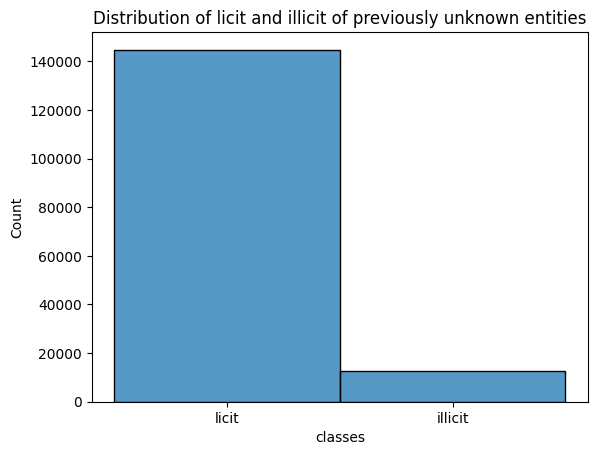
# function to create a networkx graph for each time step
def plot(i):
time_step_i = df.loc[(df['time step'] == i), 'id']
time_step_i = df_edgelist.loc[df_edgelist['txId1'].isin(time_step_i)]
g = nx.from_pandas_edgelist(time_step_i, source = 'txId1', target = 'txId2', create_using = nx.DiGraph())
return g
from graspologic.utils import is_fully_connected
for i in range (1,50):
time_step_i = df.loc[(df['time step'] == i), 'id']
time_step_i = df_edgelist.loc[df_edgelist['txId1'].isin(time_step_i)]
g = nx.from_pandas_edgelist(time_step_i, source = 'txId1', target = 'txId2', create_using = nx.DiGraph())
if(is_fully_connected(g) == True):
# print("Time Step ", i, "is strongly connected.")
pass
else:
if(nx.is_weakly_connected(g) == True):
print("Time Step ", i, "is weakly connected.")
else:
print("Time Step ", i, "isn't connected.")
# Because no statements were printed, all nodes in each time step are strongly connected.
# This what Elliptic says about the data, each component is completely connected.
From this point forward, we’ll be doing most of our measures on a time step 27. Not only will this increase our processing times, our measures will make more sense as all nodes within time step 27 are strongly connected. The reason why we chose time step 27 is because it is the time step with the least number of nodes.
# Computing the eigenvector centrality
def map_to_nodes(node_map):
node_map.setdefault(0)
# utility function to make it easy to compare dicts to array outputs
return np.array(np.vectorize(lambda x: node_map.setdefault(x, 0))(nodelist))
g = plot(27)
nodelist = list(g.nodes)
eg_centrality = map_to_nodes(dict(nx.eigenvector_centrality(g, max_iter=1000)))
eg_centrality.sort()
betweenness_centrality = map_to_nodes(nx.betweenness_centrality(g))
betweenness_centrality.sort()
# plotting Time Step 27
import time
from pathlib import Path
import pandas as pd
import networkx as nx
import numpy as np
from scipy.sparse import csr_array
from graspologic.partition import leiden
g = plot(27)
nodelist = list(g.nodes)
adj = nx.to_scipy_sparse_array(g, nodelist=nodelist)
# the below function simply just converts a graph to be undirected.
# we can use the networkx function because our graph isn't weighted
def symmetrze_nx(g):
"""Leiden requires a symmetric/undirected graph. This converts a directed graph to
undirected just for this community detection step"""
sym_g = g.to_undirected()
return sym_g
sym_g = symmetrze_nx(g)
out2 = leiden(sym_g)
node_df = pd.Series(out2)
node_df.index.name = "node_id"
node_df.name = "community"
node_df = node_df.to_frame()
nodelist = node_df.index
adj = nx.to_scipy_sparse_array(g, nodelist=nodelist)
node_df["strength"] = adj.sum(axis=1) + adj.sum(axis=0)
node_df['rank_strength'] = node_df['strength'].rank(method='dense')
from graspologic.embed import LaplacianSpectralEmbed
from graspologic.utils import pass_to_ranks
ptr_adj = pass_to_ranks(adj)
lse = LaplacianSpectralEmbed(n_components=32, concat=True)
lse_embedding = lse.fit_transform(adj)
from umap import UMAP
n_components = 32
n_neighbors = 32
min_dist = 0.8
metric = "cosine"
umap = UMAP(
n_components=2,
n_neighbors=n_neighbors,
min_dist=min_dist,
metric=metric,
)
umap_embedding = umap.fit_transform(lse_embedding)
node_df["x"] = umap_embedding[:, 0]
node_df["y"] = umap_embedding[:, 1]
def subsample_edges(adjacency, n_edges_kept=100_000):
row_inds, col_inds = np.nonzero(adjacency)
n_edges = len(row_inds)
if n_edges_kept > n_edges:
return adjacency
choice_edge_inds = np.random.choice(n_edges, size=n_edges_kept, replace=False)
row_inds = row_inds[choice_edge_inds]
col_inds = col_inds[choice_edge_inds]
data = adjacency[row_inds, col_inds]
return csr_array((data, (row_inds, col_inds)), shape=adjacency.shape)
from graspologic.plot import networkplot
# this is optional, may not need depending on the number of edges you have
sub_adj = subsample_edges(adj, 100_000)
ax = networkplot(
sub_adj,
x="x",
y="y",
node_data=node_df,
node_size="rank_strength",
node_sizes=(10, 80),
figsize=(10, 10),
node_hue="community",
edge_linewidth=0.3,
)
ax.axis("off")
(-8.944562411308288,
15.430572485923767,
-3.235624873638153,
16.602758252620696)

node_df_grouped = node_df.groupby(['community'])['community'].count().sort_values(ascending=False)
node_df_grouped
node_df_largest_communities = node_df[(node_df["community"] == 1) | (node_df["community"] == 2) | (node_df["community"] == 12) | (node_df["community"] == 22) | (node_df["community"] == 5)]
node_df_largest_communities
| community | strength | rank_strength | x | y | |
|---|---|---|---|---|---|
| node_id | |||||
| 294468623 | 1 | 1 | 1.0 | -7.083713 | 6.587129 |
| 294326756 | 2 | 1 | 1.0 | 11.408134 | 14.842425 |
| 294370619 | 22 | 2 | 2.0 | 7.499983 | 10.402857 |
| 294372200 | 1 | 1 | 1.0 | -7.002121 | 6.867332 |
| 294324191 | 1 | 1 | 1.0 | -7.139164 | 7.864409 |
| ... | ... | ... | ... | ... | ... |
| 1891081 | 1 | 95 | 25.0 | 8.650565 | 13.803895 |
| 294374011 | 1 | 1 | 1.0 | -6.657413 | 6.512280 |
| 294300722 | 22 | 1 | 1.0 | 6.279359 | 2.508360 |
| 294375201 | 1 | 1 | 1.0 | -6.410471 | 7.060765 |
| 1757629 | 22 | 1 | 1.0 | 8.746396 | 6.634493 |
228 rows × 5 columns
# plotting five largest communities within Time Step 27
import time
from pathlib import Path
import pandas as pd
import networkx as nx
import numpy as np
from scipy.sparse import csr_array
from graspologic.partition import leiden
# g = plot(27)
# nodelist = list(g.nodes)
# adj = nx.to_scipy_sparse_array(g, nodelist=nodelist)
# # the below function simply just converts a graph to be undirected.
# # we can use the networkx function because our graph isn't weighted
# def symmetrze_nx(g):
# """Leiden requires a symmetric/undirected graph. This converts a directed graph to
# undirected just for this community detection step"""
# sym_g = g.to_undirected()
# return sym_g
# sym_g = symmetrze_nx(g)
# out2 = leiden(sym_g)
# node_df = pd.Series(out2)
# node_df.index.name = "node_id"
# node_df.name = "community"
# node_df = node_df.to_frame()
nodelist = node_df_largest_communities.index
adj = nx.to_scipy_sparse_array(g, nodelist=nodelist)
# node_df["strength"] = adj.sum(axis=1) + adj.sum(axis=0)
# node_df['rank_strength'] = node_df['strength'].rank(method='dense')
from graspologic.embed import LaplacianSpectralEmbed
from graspologic.utils import pass_to_ranks
ptr_adj = pass_to_ranks(adj)
lse = LaplacianSpectralEmbed(n_components=32, concat=True)
lse_embedding = lse.fit_transform(adj)
from umap import UMAP
n_components = 32
n_neighbors = 32
min_dist = 0.8
metric = "cosine"
umap = UMAP(
n_components=2,
n_neighbors=n_neighbors,
min_dist=min_dist,
metric=metric,
)
umap_embedding = umap.fit_transform(lse_embedding)
node_df_largest_communities["x"] = umap_embedding[:, 0]
node_df_largest_communities["y"] = umap_embedding[:, 1]
def subsample_edges(adjacency, n_edges_kept=100_000):
row_inds, col_inds = np.nonzero(adjacency)
n_edges = len(row_inds)
if n_edges_kept > n_edges:
return adjacency
choice_edge_inds = np.random.choice(n_edges, size=n_edges_kept, replace=False)
row_inds = row_inds[choice_edge_inds]
col_inds = col_inds[choice_edge_inds]
data = adjacency[row_inds, col_inds]
return csr_array((data, (row_inds, col_inds)), shape=adjacency.shape)
from graspologic.plot import networkplot
# this is optional, may not need depending on the number of edges you have
sub_adj = subsample_edges(adj, 100_000)
ax = networkplot(
sub_adj,
x="x",
y="y",
node_data=node_df_largest_communities,
node_size="rank_strength",
node_sizes=(10, 80),
figsize=(10, 10),
node_hue="community",
edge_linewidth=0.3,
)
ax.axis("off")
/Users/adikondepudi/Library/Python/3.9/lib/python/site-packages/graspologic/embed/base.py:199: UserWarning: Input graph is not fully connected. Results may notbe optimal. You can compute the largest connected component byusing ``graspologic.utils.largest_connected_component``.
warnings.warn(msg, UserWarning)
/var/folders/dk/ntqqxtcj77d6kpjl7pz6dbbr0000gn/T/ipykernel_71030/4021646743.py:60: SettingWithCopyWarning:
A value is trying to be set on a copy of a slice from a DataFrame.
Try using .loc[row_indexer,col_indexer] = value instead
See the caveats in the documentation: https://pandas.pydata.org/pandas-docs/stable/user_guide/indexing.html#returning-a-view-versus-a-copy
node_df_largest_communities["x"] = umap_embedding[:, 0]
/var/folders/dk/ntqqxtcj77d6kpjl7pz6dbbr0000gn/T/ipykernel_71030/4021646743.py:61: SettingWithCopyWarning:
A value is trying to be set on a copy of a slice from a DataFrame.
Try using .loc[row_indexer,col_indexer] = value instead
See the caveats in the documentation: https://pandas.pydata.org/pandas-docs/stable/user_guide/indexing.html#returning-a-view-versus-a-copy
node_df_largest_communities["y"] = umap_embedding[:, 1]
(-3.685612750053406,
19.581494879722595,
-4.315412318706512,
11.561751401424408)
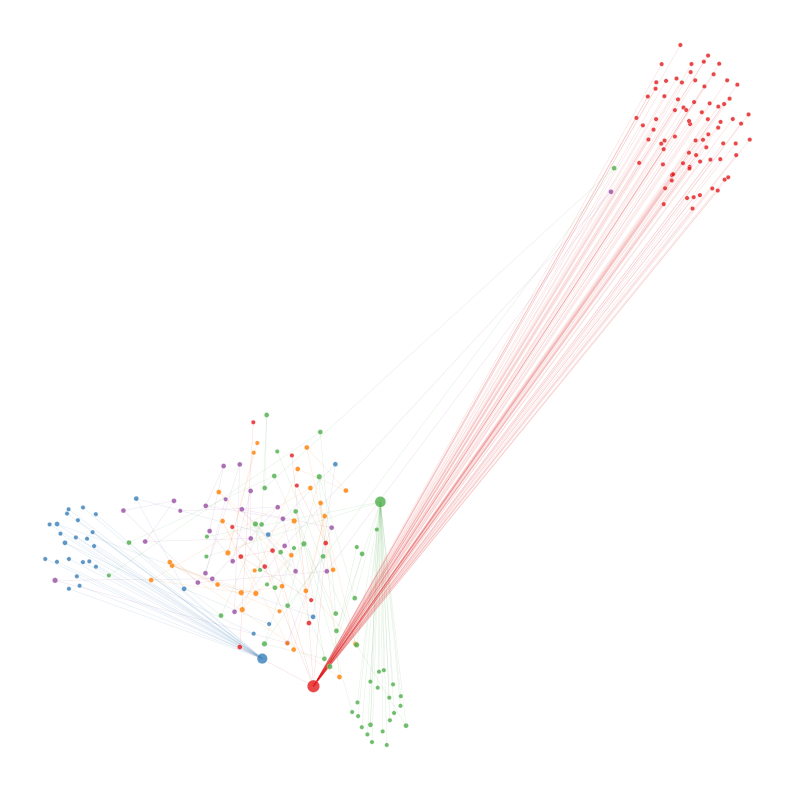
import pandas as pd
import matplotlib.pyplot as plt
from graspologic.plot import networkplot
import seaborn as sns
from matplotlib import colors
g = plot(27)
nodelist = list(g.nodes)
A = nx.to_numpy_array(g, nodelist=nodelist)
node_data = pd.DataFrame(index=g.nodes())
node_data["degree"] = node_data.index.map(dict(nx.degree(g)))
node_data["eigenvector"] = node_data.index.map(nx.eigenvector_centrality(g, max_iter = 1000))
node_data["pagerank"] = node_data.index.map(nx.pagerank(g))
node_data["betweenness"] = node_data.index.map(nx.betweenness_centrality(g))
pos = nx.kamada_kawai_layout(g)
node_data["x"] = [pos[node][0] for node in node_data.index]
node_data["y"] = [pos[node][1] for node in node_data.index]
sns.set_context("talk", font_scale=1.5)
fig, axs = plt.subplots(1, 4, figsize=(20, 5))
def plot_node_scaled_network(A, node_data, key, ax):
# REF: https://github.com/mwaskom/seaborn/blob/9425588d3498755abd93960df4ab05ec1a8de3ef/seaborn/_core.py#L215
levels = list(np.sort(node_data[key].unique()))
cmap = sns.color_palette("Blues", as_cmap=True)
vmin = np.min(levels)
norm = colors.Normalize(vmin=0.3 * vmin)
palette = dict(zip(levels, cmap(norm(levels))))
networkplot(
A,
node_data=node_data,
x="x",
y="y",
ax=ax,
edge_linewidth=1.0,
node_size=key,
node_hue=key,
palette=palette,
node_sizes=(5, 200),
node_kws=dict(linewidth=1, edgecolor="black"),
node_alpha=1.0,
edge_kws=dict(color=sns.color_palette()[0]),
)
ax.axis("off")
ax.set_title(key.capitalize())
ax = axs[0]
plot_node_scaled_network(A, node_data, "degree", ax)
ax = axs[1]
plot_node_scaled_network(A, node_data, "eigenvector", ax)
ax = axs[2]
plot_node_scaled_network(A, node_data, "pagerank", ax)
ax = axs[3]
plot_node_scaled_network(A, node_data, "betweenness", ax)
fig.set_facecolor("w")

sns.pairplot(
node_data, vars=["degree", "eigenvector", "pagerank", "betweenness"], diag_kind="kde", height=4
)
<seaborn.axisgrid.PairGrid at 0x2e6458d90>
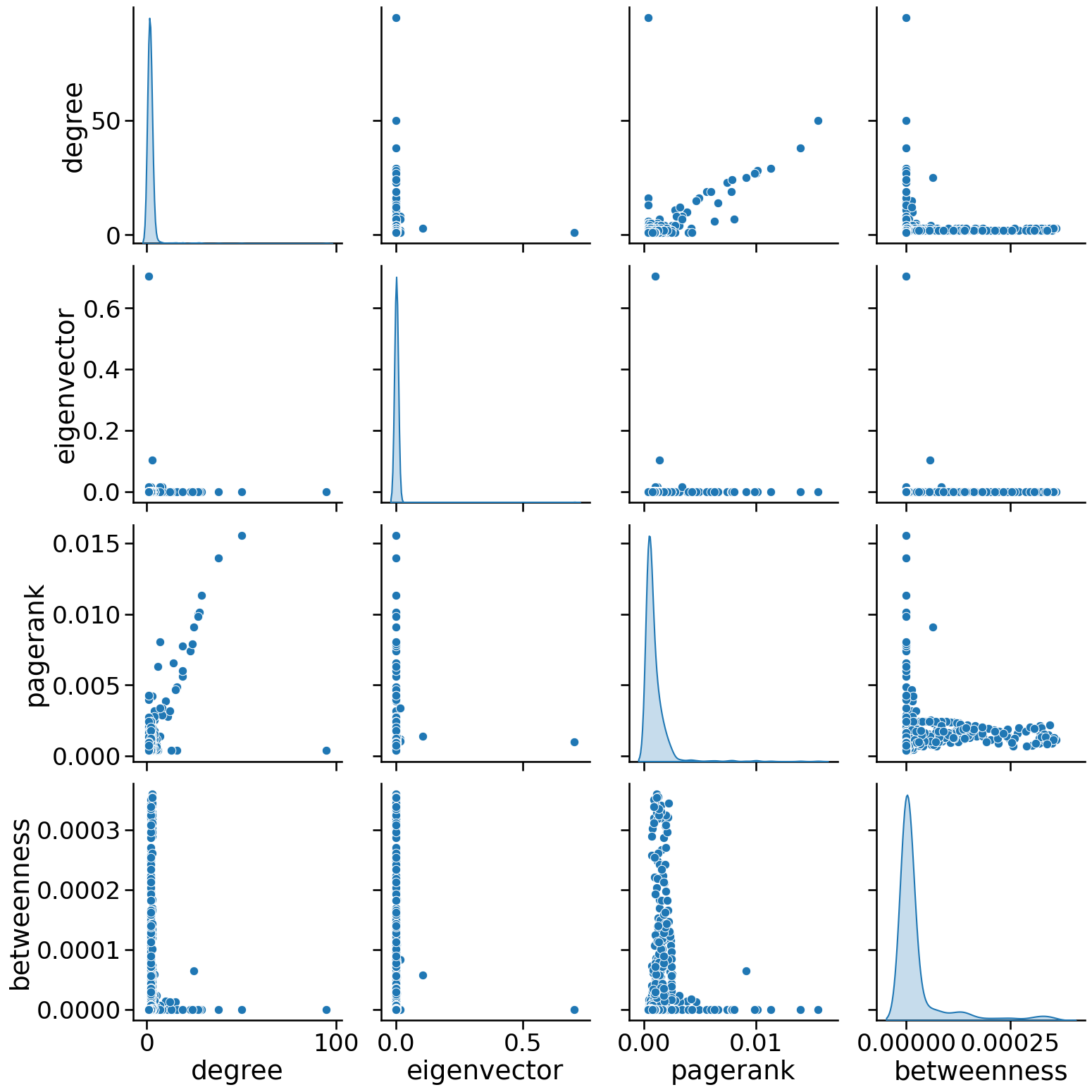
Here we try some community detection, in this case we’re attempting to divide the network into two communities. This is mostly just to test the algorithims and learn the techniques, as the network we have isnt’t made to be split communities.
First, we’ll start with Naive Optimization
import networkx as nx
import pandas as pd
g = plot(27)
nodelist = list(g.nodes)
node_df = pd.DataFrame(index=nodelist)
pos = nx.kamada_kawai_layout(g)
xs = []
ys = []
for node in nodelist:
xs.append(pos[node][0])
ys.append(pos[node][1])
xs = np.array(xs)
ys = np.array(ys)
node_df["x"] = xs
node_df["y"] = ys
adj = nx.to_numpy_array(g, nodelist=nodelist)
n = adj.shape[0]
node_df["degree"] = adj.sum(axis=0)
# random bernoullis
rng = np.random.default_rng(888)
partition = rng.binomial(1, 0.5, size=n)
partition
array([0, 0, 0, ..., 0, 0, 1])
def modularity_from_adjacency(sym_adj, partition, resolution=1):
if isinstance(partition, dict):
partition_labels = np.vectorize(partition.__getitem__)(
np.arange(sym_adj.shape[0])
)
else:
partition_labels = partition
partition_labels = np.array(partition_labels)
in_comm_mask = partition_labels[:, None] == partition_labels[None, :]
degrees = np.squeeze(np.asarray(sym_adj.sum(axis=0)))
degree_prod_mat = np.outer(degrees, degrees) / sym_adj.sum()
mod_mat = sym_adj - resolution * degree_prod_mat
return mod_mat[in_comm_mask].sum() / sym_adj.sum()
mod_score = modularity_from_adjacency(adj, partition)
mod_score
-0.014742446988177846
from graspologic.plot import networkplot, heatmap
node_df["random_partition"] = partition
def plot_network_partition(adj, node_data, partition_key):
fig, axs = plt.subplots(1, 2, figsize=(15, 7))
networkplot(
adj,
x="x",
y="y",
node_data=node_df.reset_index(),
node_alpha=0.9,
edge_alpha=0.7,
edge_linewidth=0.4,
node_hue=partition_key,
node_size="degree",
edge_hue="source",
ax=axs[0],
)
_ = axs[0].axis("off")
_ = heatmap(
adj,
inner_hier_labels=node_data[partition_key],
ax=axs[1],
cbar=False,
cmap="Purples",
vmin=0,
center=None,
sort_nodes=True,
)
return fig, ax
plot_network_partition(adj, node_df, "random_partition")
(<Figure size 1500x700 with 4 Axes>,
<AxesSubplot: title={'center': 'Betweenness'}>)

n_trials = 10000
best_scores = []
best_iterations = []
last_mod_score = mod_score
for iteration in range(n_trials):
# choose a random node to perturb
index = rng.choice(n)
# check what group it is currently in, and swap it
current_group = partition[index]
if current_group:
partition[index] = 0
else:
partition[index] = 1
# compute modularity with this slightly modified partition
mod_score = modularity_from_adjacency(adj, partition)
# decide whether to keep that change or not
if mod_score < last_mod_score:
# swap it back
if current_group:
partition[index] = 1
else:
partition[index] = 0
else:
last_mod_score = mod_score
best_scores.append(mod_score)
best_iterations.append(iteration)
mod_score
# took 95seconds!
0.401541095890411
fig, ax = plt.subplots(1, 1, figsize=(8, 6))
sns.scatterplot(x=best_iterations, y=best_scores, ax=ax, s=40, linewidth=0)
ax.set(ylabel="Modularity", xlabel="Iteration")
ax.spines.right.set_visible(False)
ax.spines.top.set_visible(False)

node_df["naive_partition"] = partition
plot_network_partition(adj, node_df, "naive_partition")
(<Figure size 1500x700 with 4 Axes>,
<AxesSubplot: xlabel='Iteration', ylabel='Modularity'>)
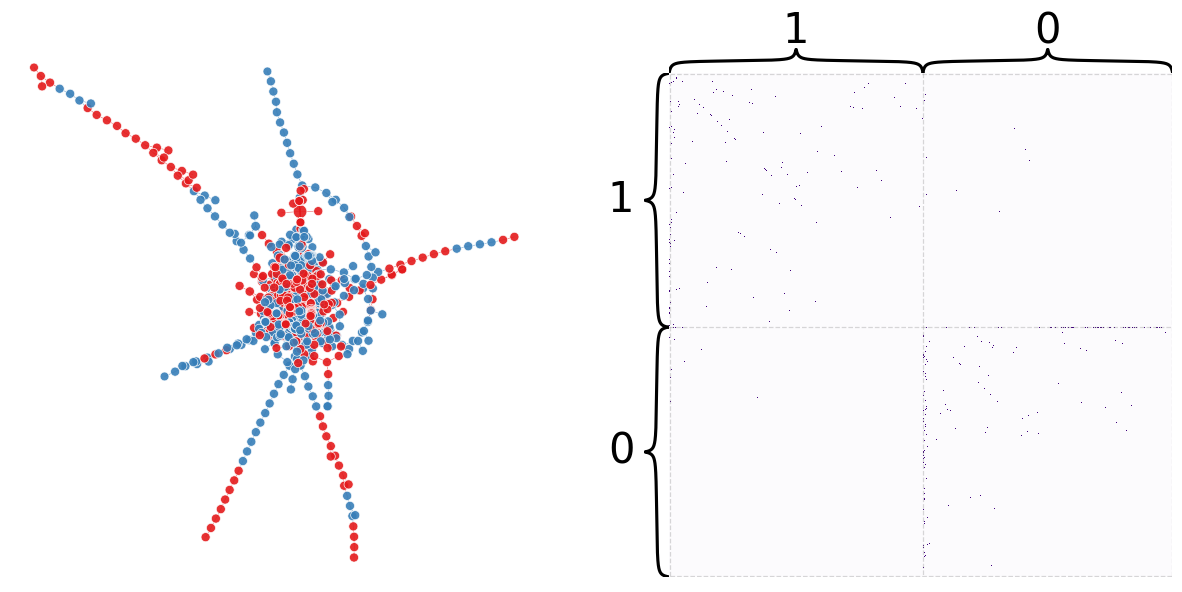
Both spectral and leidan optimization require the network to be undirected. The following code will convert the directed network into being undirected.
def symmetrze_nx(g):
sym_g = g.to_undirected()
return sym_g
Spectral optimization:
g = symmetrze_nx(g)
B = nx.modularity_matrix(g, nodelist=nodelist)
eigenvalues, eigenvectors = np.linalg.eigh(B)
first_eigenvector = np.squeeze(np.asarray(eigenvectors[:, -1]))
eig_partition = first_eigenvector.copy()
eig_partition[eig_partition > 0] = 1
eig_partition[eig_partition <= 0] = 0
eig_partition = eig_partition.astype(int)
modularity_from_adjacency(adj, eig_partition)
<class 'networkx.utils.decorators.argmap'> compilation 25:5: FutureWarning: modularity_matrix will return a numpy array instead of a matrix in NetworkX 3.0.
0.24689053996997573
node_df["eig_partition"] = eig_partition
plot_network_partition(adj, node_df, "eig_partition")
(<Figure size 1500x700 with 4 Axes>,
<AxesSubplot: xlabel='Iteration', ylabel='Modularity'>)
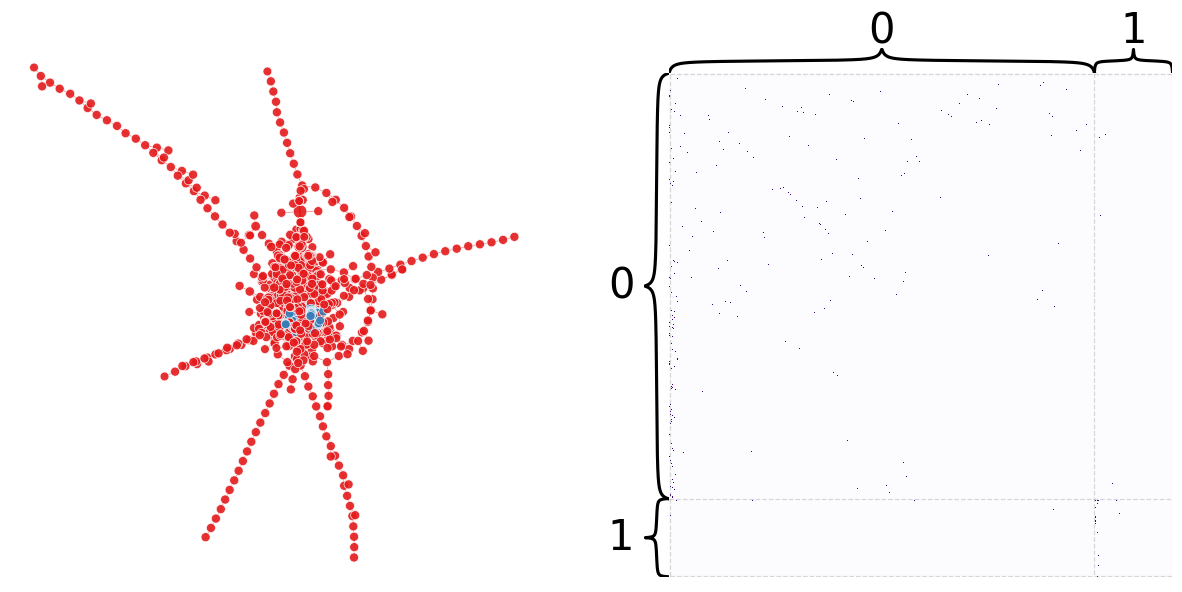
That was pretty bad… let’s try leiden!
from graspologic.partition import leiden, modularity
leiden_partition_map = leiden(g, random_seed=7)
nx.set_edge_attributes(g, 1, "weight")
modularity(g, leiden_partition_map)
0.9048667960686809
node_df["leiden_partition"] = node_df.index.map(leiden_partition_map)
plot_network_partition(adj, node_df, "leiden_partition")
(<Figure size 1500x700 with 4 Axes>,
<AxesSubplot: xlabel='Iteration', ylabel='Modularity'>)
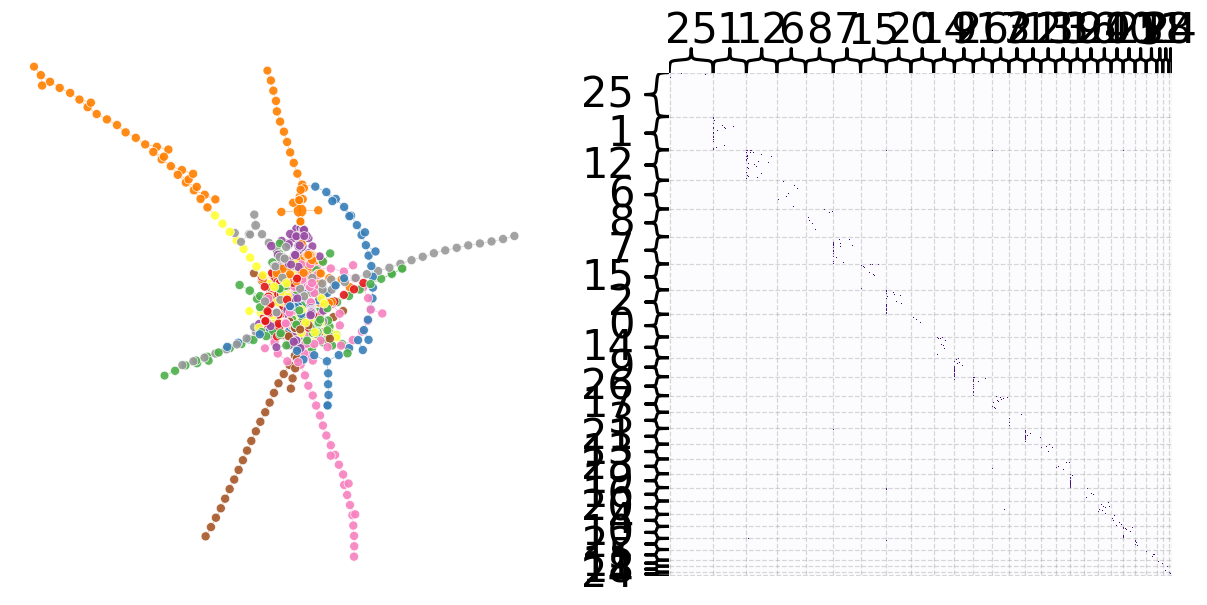
g = plot(27)
in_degree = list(g.in_degree())
df_in_degree = pd.DataFrame(in_degree, columns =['id', 'in degree'])
out_degree = list(g.out_degree())
df_out_degree = pd.DataFrame(out_degree, columns =['id', 'out degree'])
df_in_out_degree = pd.merge(df_in_degree, df_out_degree, how="inner", on="id")
df_in_out_degree_1_1 = df_in_out_degree.loc[(df_in_out_degree['in degree'] == 1) & (df_in_out_degree['out degree'] == 1)]
df_in_out_degree_0_1 = df_in_out_degree.loc[(df_in_out_degree['in degree'] == 0) & (df_in_out_degree['out degree'] == 1)]
df_in_out_degree_1_0 = df_in_out_degree.loc[(df_in_out_degree['in degree'] == 1) & (df_in_out_degree['out degree'] == 0)]
print(df_in_out_degree_1_1.shape)
print(df_in_out_degree_0_1.shape)
print(df_in_out_degree_1_0.shape)
print(df_in_out_degree.shape)
(348, 3)
(302, 3)
(211, 3)
(1089, 3)
228
348 of the 1089 nodes (32%) have an in degree and an out degree of 1.#
302 of the 1089 nodes (32%) have an in degree of 0 and an out degree of 1.#
211 of the 1089 nodes (32%) have an in degree of 1 and an out degree of 0.#
If we look at the graph above, we can see there are chains of nodes. It seems that occasionally, there are transactions that pass through a chain of entities. These entities simply receieve the transaction from one entity and transfer it to the next. We can reason that this could potentially be a part of a money laundering operation, specifically layering. In this step, money is transfered through multiple accounts to further the distance from the money from the original source. These entities are likely shell companies, trusts, or other corporate vehicles which aren’t required to reveal their true owner.#
copy_df_in_out_degree = df_in_out_degree
print(copy_df_in_out_degree.shape)
# drop the rows from df1 where the value in the 'id' column matches a value in the 'id' column of df2
copy_df_in_out_degree = copy_df_in_out_degree[~copy_df_in_out_degree['id'].isin(df_in_out_degree_1_1['id'])]
print(copy_df_in_out_degree.shape)
copy_df_in_out_degree = copy_df_in_out_degree[~copy_df_in_out_degree['id'].isin(df_in_out_degree_0_1['id'])]
print(copy_df_in_out_degree.shape)
copy_df_in_out_degree = copy_df_in_out_degree[~copy_df_in_out_degree['id'].isin(df_in_out_degree_1_0['id'])]
print(copy_df_in_out_degree.shape)
(741, 3)
(532, 3)
(288, 3)
(110, 3)
